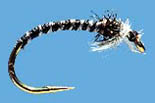Ya Gotta Love Them Midges - eh?
The Crow Midge beadhead is simple and effective
by Clive Schaupmeyer
Midges make up a huge portion of the trout diet in cold waters like we have here in western Canada. Bigger insects are often more obvious because of their size, but mayfly, caddisfly and stonefly activity comes and goes. Midges are always around and trout feed on them 12 months a year!
If you fish trout waters (where your standard nymphs are not producing in the colder parts of the year) you may want to tie up a few of my favorite midge pattern-the Crow Midge. But first the science lesson ...
Midges belong to the order Diptera: di meaning "two' and ptera meaning "wings." These are flies. More precisely they belong to the midge family, Chironomidae. The mosquito-like midges range in size from about one-half inch (12 mm) all the way down to no see um size-less than one-eighth inch (3 mm) in length. Larger midges are not uncommon on some waters. The most common body colors where I fish are black, dark charcoal grey and shades of brown. Green and red midges are found elsewhere.
Midges undergo complete metamorphosis. The larvae develop from eggs and turn into pupae before they emerge as adults. Trout eat larvae, pupae, emerging adults and adults: all imitated with small "nymph" and dry-fly patterns. Midges flies are small, and hook sizes ranging from #16 to #22 will normally be required to match the natural size closely. There are some larger species-up to size #12-in some waters. And some are real small-#26!
The pictures show two midge pupa patterns that produce well. The one with peacock herl and white ostrich herl at the head was shown to me by my brother a few years ago. I first tied the Crow Midge bead last September after buying some of the small pearl plastic beads in the Crowsnest Angler Fly Shop. The beads seemed like a natural addition to he standard midge pattern-and I have not been disappointed. And neither have several friends. This fly is a winner! The standard midge pupa shown here has been used by fly anglers I've met in the FAOL chat room and they report good results.

Crow Midge | 
Midge Pupa |
The materials for these flies are:
- Tiemco 2457 hook (#14 or #16);
- body of black tying thread;
- grey thread rib, wrapped five or six turns.
For the Crow Midge bead pupa place the bead on first and after tying the body and rib, wrap two turns of peacock herl behind the bead. For the standard pattern, (no bead) wrap two turns of peacock followed by two wraps of white ostrich herl. (These sizes may sound large but these are 2X short hooks and if these hooks are tied sparsely then the resulting bodies are closer to standard #16 to #20 flies.)
Both of these patterns are a boon to fly tyers: they are simple and effective! Based on several trips between last September and this March, the Crow Midge seems to be the better of the two. Time will tell.
These pupae imitations are usually fished near the bottom. Because they are so small, I don't feel confident fishing them alone, so I (almost) always tie a pupa pattern-to be fished on the bottom-with a larger fly. But don't mistake my confidence for lack of optimism. Over the past few years, I have caught more trout on midge pupae patterns than any other single type of wet fly. Trout eat a lot of midges and if you have not been using midge pupae patterns, then it's time to start.
On March 31 (two weeks ago) I found a few rainbows feeding in about one foot of water-they were occasionally taking midge adults off the surface. Instead of switching to a dry fly I continued fishing the Crow Midge, but not from a dropper as usual. I tied a small piece of white foam indicator only 2 feet above the single fly. I cast upstream into the head of the riffle and allowed the unweighted fly to drift towards me. Rainbows were caught.
Closing thought: I approached my 51st birthday (last week) from several directions. Mainly from the middle and backside. - CS
Return to Index
Copyright ©1998 Clive Schaupmeyer
Clive Schaupmeyer is an outdoor writer and photographer. He is the author of
The Essential Guide to Fly-Fishing,
a 288-page book for novice and intermediate fly anglers. His photo of a boy
fishing was judged the best outdoor picture of 1996 published by a member of
the Outdoor Writers of Canada. He fly-fishes for trout in Alberta's foothill
and mountain streams and for pike near his home in Brooks, Alberta.
Our Man In Canada Archives
|



